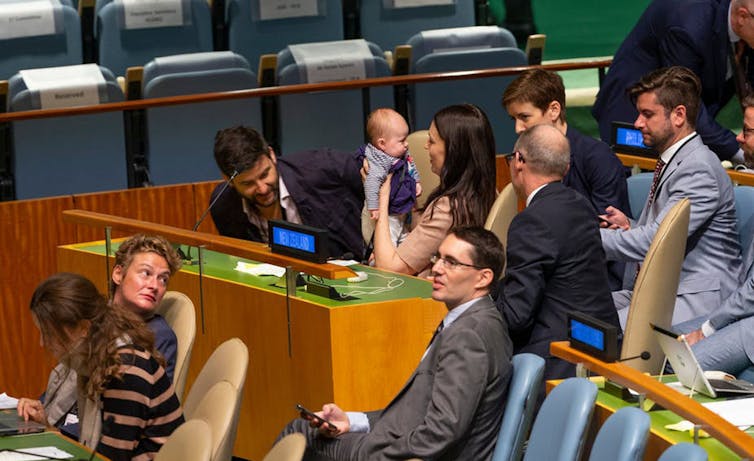Conversation parents and careers
Comment: It's only a baby, right? Prime ministers and parenthood
Published on: 18 October 2018
Writing for The Conversation, Dr Tracy Scurry and colleagues discuss whether there are differences in the treatment of mothers and fathers' careers.

Mark Smith, Grenoble École de Management (GEM); Marilyn Clarke, University of Adelaide, and Tracy Scurry, Newcastle University
Over the summer of 2018, New Zealand prime minister Jacinda Arden returned from her six-week period of maternity leave to take up the reins of government. The media interest in her pregnancy and her capabilities to do her job seem at odds with the lives of millions of working mothers already doing two “jobs”. Are there ongoing differences in the treatment of mothers and fathers’ careers or is politics just different?
Careers and careers in politics
All over the world working women are having children, taking leave and returning to work yet somehow it seems that being a political leader is one of the last bastions of conservatism, particularly in relation to the impact of parenting on the capability to perform at work. Indeed in resigning from her post at the US State Department Anne-Marie Slaughter famously wrote “women can’t have it all”.
The press interest in fathers in political office has been more limited and focused on whether they would take their right to parental leave, albeit short, rather than if they could still do the job – examples include the Finnish prime minister Paavo Lipponen in 1997 and the UK’s Tony Blair in 1999.
There is in fact just one other example of a female prime minister having a child while in office, that of the late Benazir Bhutto who gave birth to a son in 1990. At the time, opposition politicians poured scorn on her ability to be a new mother and leader. Even now we see many women political leaders rising to the top who do not have children (e.g., Teresa May, Angela Merkel, Julia Gillard etc.) or who have followed more traditional trajectories and had children before their political career (e.g., Annegret Kramp-Karrenbauer, Hilary Clinton, etc.).
Everyday pressures without the publicity
In other professional fields fewer questions are openly asked of top women when they have children, for example in the tech sector [Sheryl Sandberg at Facebook or Marissa Mayer at Yahoo. Yet these questions are not necessarily absent, just less public.
The publicity on Jacinda Arden is a lens on more subtle social processes, gendered questions and social norms that are still at work. Indeed these norms are still shaping who is, and who is not, seen as appropriate for certain careers or what women and men “should” do as parents. The recent furore over boosting men’s grades to exclude women from medical school highlights an extreme of these views that persist more subtly in many contexts.
Research on careers and work life highlights how parenting and having a career is a challenging balancing act. We often talk here about work-life balance but it is perhaps more accurate to talk of work-life integration as parents manage the borders between working and family lives. The reality is that for many a harmonious “balance” is elusive and borders are permeable.
But it is not necessarily a negative balancing act. In focusing on the borders, researchers have focused on the interaction between work and family domains and analysed what is known as spillover. This spillover can be negative where work has negative consequences (conflict) on family life, for example postponing holidays due to a work emergency or, vice versa, stress of a family emergency impacting upon performance at work. There can also be positive spillovers whereby each domain, work to family or family to work, enriches the other. For example, competences in one domain may help in the other, or benefits may arise from an accumulation of roles in terms of greater wellbeing.
Not the same, not equal
The challenge is that these work-family domains and borders, and associated spill overs, are no necessarily viewed the same way for women and men. Research differentiates between the positive effects on men of fatherhood compared to the negative career consequences often experienced by women. The so-called fatherhood wage premium and/or perception of maturity and reliability experienced by men is in contrast to the motherhood wage penalty, more restricted job opportunities and the “mommy track”. Furthermore, the positive development opportunities for men in terms of fathers’ family-work enrichment can be perceived as greater than for women.
Similarly, family domains are not equal. In many countries women now account for more or less half of the working population and working mothers are increasingly the norm. Yet women with children often adjust their working patterns and this is often put down to the unchanging nature of the gender division of unpaid work in the home – women do more than men in the family domain.
Work together as a household
The story of Jacinda Arden not only sheds light on these more subtle processes that are going on in many men’s and women’s lives but also demonstrates how a couple can work together in order to develop an improved work-family integration. This requires a level of coordination and negotiation within the couple to ensure that mothers and fathers can succeed in both their careers and be satisfied as parents. Sheryl Sandberg spoke frequently of this coordination with her late husband and the need to work as a household, truly sharing roles in the home.
Men may also face barriers in being active parents and supportive to their female working partners as they necessarily are required to stand out from the norm: social norms around masculinity play a role in creating norms of what fathers “should” do. The evidence of men’s slow change in behaviour can be seen in the low take up of parental leave, even in countries where there are obligatory male allocations for leave.
Women also have a role in encouraging their male partners to adapt their behaviour to the realities of dual-careers couples and not to the behavioural standards of previous generations. Even in households where couples try to share the care, housework and cooking there are social pressures to adopt certain roles that reinforce traditional norms whether they come from family, friends, the workplace or wider society.
Times are a-changin’ but barriers remain
Responses to Prime Minister Arden’s parenthood have been much more positive than that for Benazir Bhutto 30 years ago and there is no turning the clock back. Yet working parents need support to undertake their roles via institutions that aid working families and supportive employers. And, just as importantly, individuals themselves need to recognise the impact of their own “choices” on theirs and their spouses’ working lives and that they themselves are agents of change.
Mark Smith, Dean of Faculty & Professor of Human Resource Management, Grenoble École de Management (GEM); Marilyn Clarke, Senior Lecturer in HRM, University of Adelaide, and Tracy Scurry, Senior Lecturer in Human Resource Management, Newcastle University
This article is republished from The Conversation under a Creative Commons license. Read the original article.



